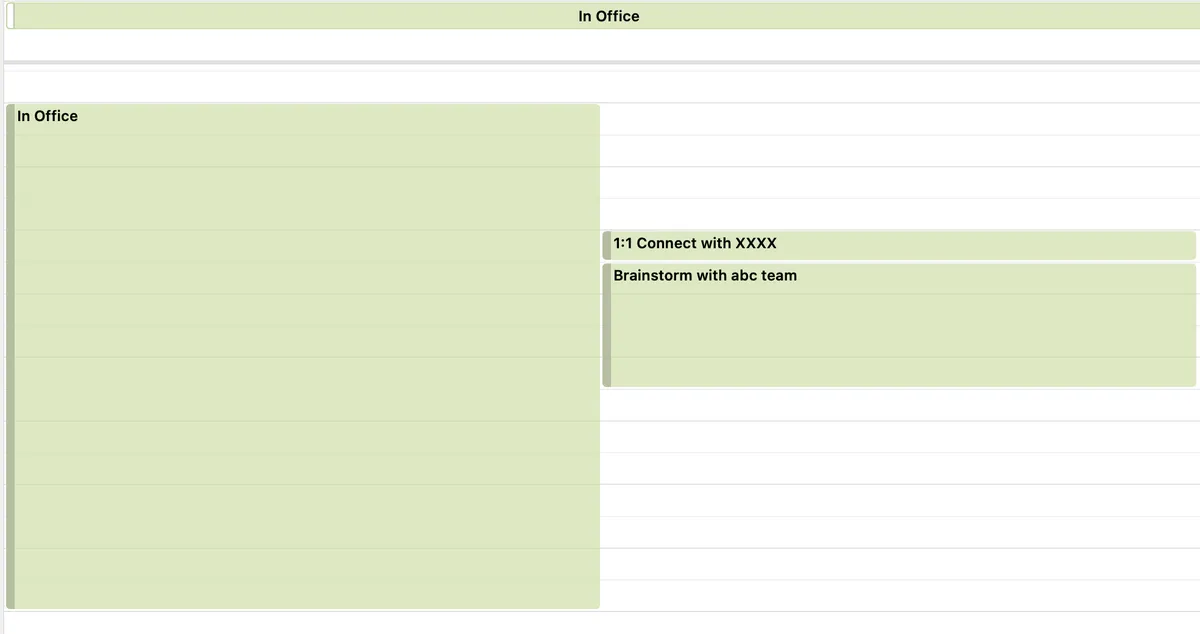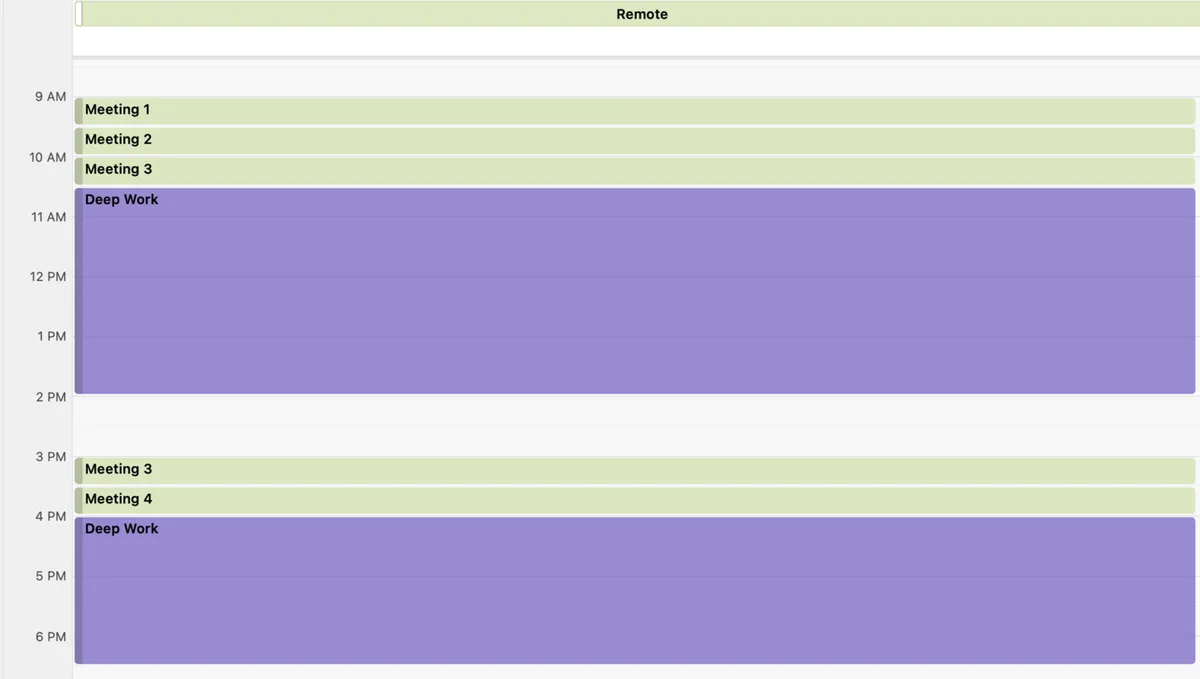Hybrid Work - Everything I’ve learnt so far
Over the last few months, I’ve been trying to work out what works and what doesn’t in a hybrid work environment. I define hybrid work as coming to the office 1-2 days a week and working from wherever you want for the other days of the week.
Hybrid work, if done right, can enable the best of both worlds - you get to interact with your colleagues in person, build relationships, a sense of belonging and connect like you cannot do on a Zoom call (at least not so far). And it gives you the flexibility to work from anywhere for most of the week and enables you to do a lot more deep work. The limitation is that you will still need to live close to an office.
Here’s everything I’ve learnt so far in my short hybrid work journey.
Working from the office
Be thoughtful about when to be in the office and what you plan to accomplish when in the office. I’ve found it helpful to coordinate my visits with the rest of my team. And this also removes proximity bias. Most of the team is in the office on the same days, along with their leads.
Try to keep Zoom calls to a bare minimum when in the office. And when it’s unavoidable, ensure that it’s run with the same processes that you follow when running a remote meeting. When in the office, I have very few scheduled calls. I mostly try and optimise for impromptu, unplanned conversations. Unfortunately, the current technology available cannot simulate spontaneous conversations (although that might change in the future).
I’ve found that the following conversations (not an exhaustive list) work better when done in person.
Building a sense of belonging and trust
1:1 mentoring, feedback
Complex Brainstorms
Setting Context
Teaming
But often, when you have conversations in the office relevant to other team members, make sure the meeting notes from the discussions are compiled and shared with everyone on the team.

Fig 1. An example of what my calendar typically looks like when I'm in office. There are very few meetings and the meetings that are on my calendar are the ones that are best done in-person.
In a new world where the why behind "why we come to the office" is changing, office design has to evolve very quickly. Rows of cubicles should give way to more collaborative spaces, and offices should be designed to enable collision (As always, Steve Jobs figured this out way before anyone else). Offices also need to invest in state-of-the-art meeting room technology to ensure seamless hybrid meetings.
Working Remote
Working remote is when I’m able to get most of my work done. Remote works best with an async first approach to work with minimal meetings. Async work deserves it's own article and I'll publish one soon. The headline here is that set context synchronously and execute asynchronously. Think long and hard if you need a meeting or if an audio message or a thoughtfully crafted note would suffice. By using this mental model, I’ve been able to cut down the number of meetings at work by 60%.
 Fig 2. An example of what my calendar typically looks like when I'm remote. My meetings are bunched together so that I have long periods blocked for deep work.
Fig 2. An example of what my calendar typically looks like when I'm remote. My meetings are bunched together so that I have long periods blocked for deep work.
When I'm remote, I've also found it useful to connect with my colleagues in coffee shops or more informal settings once in a while. And I've seen a lot of other folks do the same. In the future, we'll probably see companies enabling subscriptions to coffee shops and cafés. No alt text provided for this image
 Fig 3. Via https://blog.doist.com/async-first/
Fig 3. Via https://blog.doist.com/async-first/
For leaders, it’s important to focus on outcomes than any other metric. I firmly believe that if leaders are thoughtful about cutting down on meetings, move away from an ASAP culture and enable large pockets of deep work time for their teams, productivity can go through the roof. Ways of working in a hybrid work environment
Here are a few ways of working that have helped me and the teams I work with stay productive in a hybrid work environment.
Document everything - Building a historical context for decisions, ideas, plans, meetings etc. and making them searchable can be a game changer and can help build a bias-free environment. If documentation is not prioritised, the talent that is not part of conversations might get left behind. Effective documentation can also drastically increase productivity and prevent repeating conversations about the same topic (this adds up quickly with large teams).
Use multiplayer software - Multiplayer software enables collaboration in real-time. Google Docs and Sheets pioneered the ability to work on the same document, and now this feature will eventually be part of every piece of software. The future of software is multiplayer. If you want to learn more about the subject, I highly recommend this brilliant article by Kevin Kwok. All the software I use to collaborate at work is multiplayer (office.com docs and excels, Figma etc.).
Audio is underrated - I've found audio useful in a remote work environment. I now use audio messages almost as much as written notes. I highly recommend that everyone try this out. I've also found the speech-to-text feature in Outlook handy. I now routinely use voice-to-text to dump all my thoughts and edit later.
Be very thoughtful about how you run meetings - While I'm a huge fan of an async first approach to work, that doesn't mean meetings aren't useful. They are critical to the success of an org, but if not done right can ruin the work culture. I'll write another article on some lessons learnt in running hybrid meetings. I'll leave you with two of the most important lessons I've learnt. Don't have a meeting without an agenda (ideally, share readouts well before a call); always use multi player software and collaboratively document the notes from a meeting with clear action items and next steps.
Say no to an ASAP culture - Say no to ASAP deadlines. Most "important" todos can wait another day. ASAP deadlines wreak havoc on productivity (you are interrupted from whatever you are working on) and often lead to suboptimal work and decision-making. Thoughtful work and decisions need time.
Democratise information and kill information hierarchy - Ensure that all relevant data about a project or data relevant to the team is available to everyone on the team. This helps create a fair environment where everyone has equal access to information and opportunity. Always err on the side of over communication.
Hire and enable more “Managers of One” - The brilliant minds from Basecamp coined this term. “A manager of one is someone who comes up with their own goals and executes them. They don’t need heavy direction. They don’t need daily check-ins. They do what a manager would do — set the tone, assign items, determine what needs to get done, etc. — but they do it by themselves and for themselves " Via - Basecamp
Make writing a core skill - In a hybrid (and a remote work environment), I’m convinced that the ability to write well will become a key differentiator for companies and professionals.
Leadership traps
The post-Covid workplace will look nothing like what it was Pre-Covid. Leaders must unlearn how they worked Pre-Covid, go back to first principles and help reimagine the future of the workplace. It’s incredibly important that leaders trust their teams, focus on measuring output and not time spent at work, give up control, and spend time connecting with and understanding the goals and ambitions of the younger generation (which might be very different from that of the leaders) and build a workplace that is truly inclusive and forward-looking.
We all have a once-in-a-generation opportunity to build a workplace that enables us to excel at work and lead a full life outside of it. I’m excited about making a small contribution to the future of the workplace.